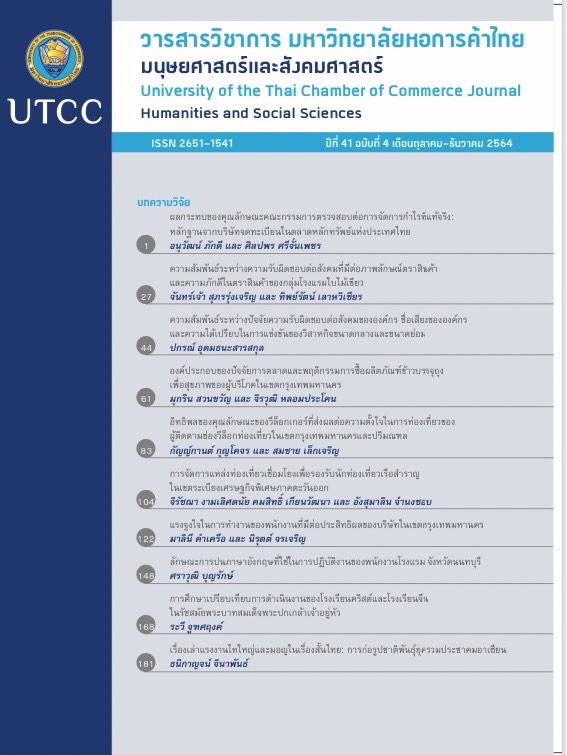Management of Linked Tourist Attractions to Accommodate Cruise Tourists in Eastern Economic Corridor
Main Article Content
Abstract
The purpose of this research was to study linked tourist attraction management to accommodate cruise tourists in Eastern Economic Corridor by using Delphi technique. Gathering data from 19 experts, who have experiences in Cruise Tourism in Eastern Economic Corridor as well as in government and private sectors. The first round of Delphi Technique was collected by semi-structure interview, then the results were used to create close-ended questionnaires with rating scale in the second and third rounds. The data from the third round were analyzed by using median, mode, |Md-Mo| and interquartile range. The criteria for determining the consensus result was the median with the minimum threshold of 3.50, the interquartile range values to be less than or equal to 1.50 and the absolute value of the difference between median and mode to be less than or equal to 1.00. The research result was found that overall consensus was ranked in the most level of mutual agreement (Md = 5.00, Mo = 5.00, |Md-Mo| = 0.00, IR = 0.70). Furthermore, expert consensus agreed on the highest levels in terms of attractions, facilities, accessibility, security, tourism marketing and tourist management, respectively.
Article Details

This work is licensed under a Creative Commons Attribution-NonCommercial-NoDerivatives 4.0 International License.
ลิขสิทธิ์ของบทความ
ผลงานที่ได้รับการตีพิมพ์ถือเป็นลิขสิทธิ์ของมหาวิทยาลัยหอการค้าไทย ห้ามมิให้นำเนื้อหา ทัศนะ หรือข้อคิดเห็นใด ๆ ของผลงานไปทำซ้ำ ดัดแปลง หรือเผยแพร่ ไม่ว่าทั้งหมดหรือบางส่วนโดยไม่ได้รับอนุญาตเป็นลายลักษณ์อักษรจากมหาวิทยาลัยหอการค้าไทยก่อน
References
กรมการท่องเที่ยว. (2557). แนวทางการบริหารจัดการแหล่งท่องเที่ยวเชิงนิเวศ ทางประวัติศาสตร์ทางวัฒนธรรม. กรุงเทพฯ: สำนักพัฒนาแหล่งท่องเที่ยว, กลุ่มวิชาการพัฒนาแหล่งท่องเที่ยว.
การท่องเที่ยวแห่งประเทศไทย. (2545). คู่มือแนวทางการจัดการที่พักสัมผัสวัฒนธรรมชนบท. กรุงเทพฯ: การท่องเที่ยวแห่งประเทศไทย.
ชมภูนุช หุ่นนาค. (2558). การศึกษาความเชื่อมโยงของแหล่งท่องเที่ยวในจังหวัดสมุทรสงคราม. วารสารวไลยอลงกรณ์ปริทัศน์, 5(2), 113-124.
นครินทร์ ทั่งทอง, และเพชรศรี นนท์ศิริ. (2562). การเสริมสร้างประสบการณ์ความทรงจำพิเศษของนักท่องเที่ยวเรือสำราญในท่าเรือแวะพักเพื่อพัฒนาการท่องเที่ยวทางทะเลของประเทศไทย. วารสารบริหารธุรกิจ เศรษฐศาสตร์และการสื่อสาร, 14(3), 41-55.
ปรัชมาศ ลัญชานนท์, อัจฉรี เหมสันต์, และ บรรจง สมบูรณ์ชัย. (2556). ความเชื่อมโยงของกิจกรรมด้านการท่องเที่ยวในเมืองประวัติศาสตร์เชียงใหม่. ใน การประชุมวิชาการภูมิทัศน์และสิ่งแวดล้อม ครั้งที่ 1 ก้าวสู่สีเขียวยั่งยืน, 5-6 ธันวาคม 2556 (น.110-126). เชียงใหม่: มหาวิทยาลัยแม่โจ้, คณะสถาปัตยกรรมศาสตร์และการออกแบบสิ่งแวดล้อม.
ไพฑูรย์ มนต์พานทอง. (2558). การท่องเที่ยวเรือสำราญ กับความท้าทายของประเทศไทย. TAT Review Magazine, 4(1), 45-49.
ไพฑูรย์ มนต์พานทอง, สัญชัย เกียรติทรงชัย, และนงเยาว์ ประสมทอง. (2561). การศึกษาประเด็นเร่งด่วนในการพัฒนาการท่องเที่ยวเรือสำราญของประเทศไทย. กรุงเทพฯ: สำนักงานคณะกรรมการวิจัยแห่งชาติ.
ภณสิทธ์ อ้นยะ, ณัฐพล ประดิษฐผลเลิศ, รัชต วรุณสุขะศิริ, และชวลีย์ ณ ถลาง. (2562). ปัจจัยที่มีผลต่อความสำเร็จของการบริหารจัดการแหล่งท่องเที่ยวตามมาตรฐานการท่องเที่ยวไทย. วารสารมนุษยศาสตร์และสังคมศาสตร์ มหาวิทยาลัยราชพฤกษ์, 4(3), 75-86.
มนตรี สังข์ทอง, ศศินันท์ ศาสตร์สาระ, กิตติพงษ์ โสภณธรรมภาณ, และเอกวิศว์ สงเคราะห์. (2560). แนวทางการเชื่อมโยงการท่องเที่ยวระหว่างจังหวัดพระนครศรีอยุธยา อ่างทอง และสิงห์บุรี. นนทบุรี: มหาวิทยาลัยเทคโนโลยีราชมงคล สุวรรณภูมิ.
ราณี อิสิชัยกุล, รชพร จันทร์สว่าง, และวัฒนา โชคสุวณิช. (2561). ปัญหาและอุปสรรคการเป็นท่าเรือสำราญหลักในกลุ่มท่องเที่ยวอันดามัน. วารสารวิชาการ มหาวิทยาลัยหอการค้าไทย มนุษยศาสตร์และสังคมศาสตร์, 38(4), 81-106.
สำนักงานคณะกรรมการนโยบายเขตพัฒนาพิเศษภาคตะวันออก. (2561). แผนปฏิบัติการการพัฒนาและส่งเสริมการท่องเที่ยวในพื้นที่ระเบียงเศรษฐกิจพิเศษภาคตะวันออก. สืบค้นจาก https://www.eeco.or.th/sites/default/files/3%20-%20แผนการพัฒนาท่องเที่ยว%20EEC.pdf
สุรพร มุลกุณี. (2560). แนวทางการพัฒนาการจัดการท่าเรือสำหรับการท่องเที่ยวเรือสำราญของประเทศไทย กรณีศึกษาท่าเรือแหลมฉบัง (วิทยานิพนธ์ปริญญามหาบัณฑิต ไม่ได้ตีพิมพ์). สถาบันบัณฑิตพัฒนบริหารศาสตร์, กรุงเทพฯ.
สุรพร มุลกุณี, และไพฑูรย์ มนต์พานทอง. (2560). พฤติกรรมและคุณลักษณะของนักท่องเที่ยวเรือสำราญในการเดินทางท่องเที่ยวยังท่าเรือของประเทศไทย กรณีศึกษาท่าเรือแหลมฉบัง. วารสารรัชต์ภาคย์ ฉบับพิเศษ ครบรอบ 23 ปี, 175-187.
Busby, G., & O’Neill, J. (2013). Port of call: In search of competitive advantage. European Journal of Tourist, 4(1), 123-160.
Chen, C.-A. (2016). How can Taiwan create a niche in Asia's cruise tourism industry? Tourism Management, 55, 173-183. doi.org/10.1016/j.tourman.2016.02.015
Cruise Gateway North Sea. (2013). Sustainable cruise tourism in the North Sea Region: Summary of a best practice guide. Retrieved from
Cruise Lines International Association. (2014). 2014 state of the cruise industry report. Retrieved from https://prnewswire2a.akamaihd.net/p/1893751/sp/189375100/thumbnail/entry_id/0_9z160blq/def_height/400/def_width/400/version/100012/type/1
Cruise Lines International Association. (2018). 2018 Asia cruise industry ocean source market report. Retrieved from https://cruising.org/-/media/research-updates/ 2018-asia-ocean-source-market.pdf
Cruise Lines International Association. (2019). 2019 Asia cruise deployment & capacity report. Retrieved from https://cruising.org/-/media/research-updates/research/2019-asia-deployment-and-capacity---cruise-industry-report.ashx
Cruise Lines International Association. (2021). 2021 state of the cruise industry outlook. Retrieved from https://cruising.org/-/media/research-updates/research/2021-state-of-the-cruise-industry_optimized.ashx
Dalkey, N., & Helmer, O. (1963). An experimental application of the delphi method to the use of experts. Management Science, 9(3), 458-467.
Gibson, P. (2006). Cruise operations management. Oxford, England: Butterworth-Heinemann.
Gibson, P. (2012). Cruise operations management (2nd ed.). London, England: Routledge.
Kurth-Schai, R., Poolpatarachewin, C., & Pitiyanuwat, S. (1998). Using the delphi cross-culturally: toward the development of policy. In J. Cogan, & R. Derricott (Eds.), Citizenship for the 21st century (pp. 77-92). London, England: Kogan.
Macmillan, T. T. (1971). The delphi technique. Paper presented at the Annual Meeting of the California Junior Colleges Associations Committee on Research and Development.
Port-Net. (2007). Challenges and future trends: Ports and passengers in Europe – The Baltic range (Tallinn, Riga, Klaipeda and Kaliningrad). Bicol, Philippines: Author.
Satta, G., Parola, F., Penco, L., & Persico, L. (2015). Word of mouth and satisfaction in cruise port destinations. Tourism Geographies, 17(1), 54-75. doi.org/10.1080/14616688.2014.938689
Tan, K. (2009). Growth of cruise tourism in Asia. Retrieved November 2, 2020, from https://slideplayer.com/slide/6061191/
Yi, S., Day, J., & Cai, L. A. (2011). Exploring Asian cruise travelers’ travel experience and perception. Retrieved from https://scholarworks.umass.edu/cgi/viewcontent.cgi?article=1245&context=gradconf_hospitality


